2016 Peugeot Expert VU check engine
[x] Cancel search: check enginePage 219 of 520
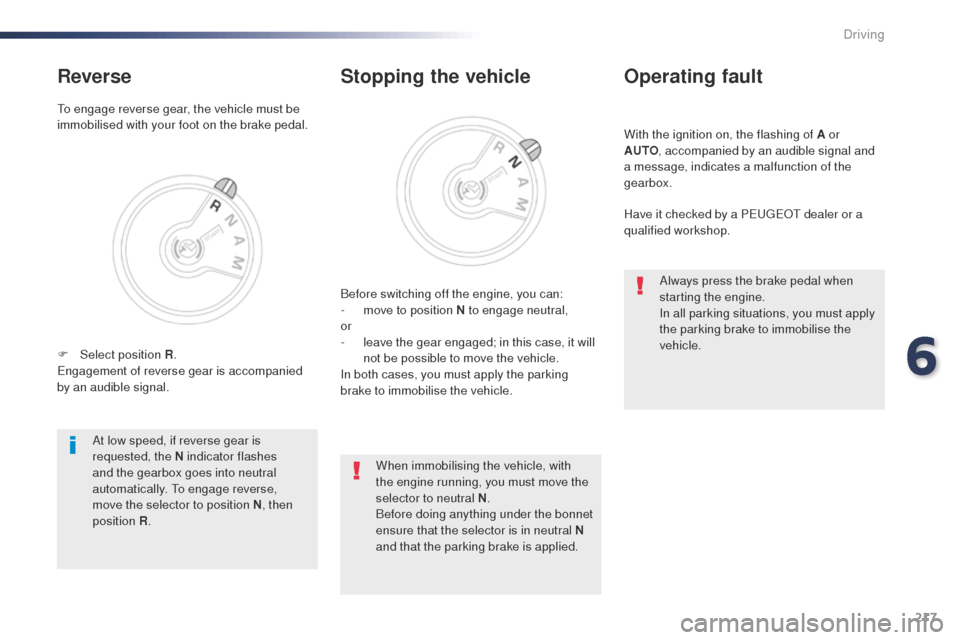
217
With the ignition on, the flashing of A or
AUTO, accompanied by an audible signal and
a message, indicates a malfunction of the
gearbox.
Operating fault
Have it checked by a Pe ugeot dealer or a
qualified workshop.
Stopping the vehicle
Before switching off the engine, you can:
- m ove to position N to engage neutral,
or
-
l
eave the gear engaged; in this case, it will
not be possible to move the vehicle.
In both cases, you must apply the parking
brake to immobilise the vehicle.
At low speed, if reverse gear is
requested, the N
indicator flashes
and the gearbox goes into neutral
automatically.
t
o
engage reverse,
move the selector to position N , then
position
R . When immobilising the vehicle, with
the engine running, you must move the
selector to neutral N
.
Before doing anything under the bonnet
ensure that the selector is in neutral N
and that the parking brake is applied. Always press the brake pedal when
starting the engine.
In all parking situations, you must apply
the parking brake to immobilise the
vehicle.
to e
ngage reverse gear, the vehicle must be
immobilised with your foot on the brake pedal.
Reverse
F Select position R .enga
gement of reverse gear is accompanied
by an audible signal.
6
Driving
Page 223 of 520
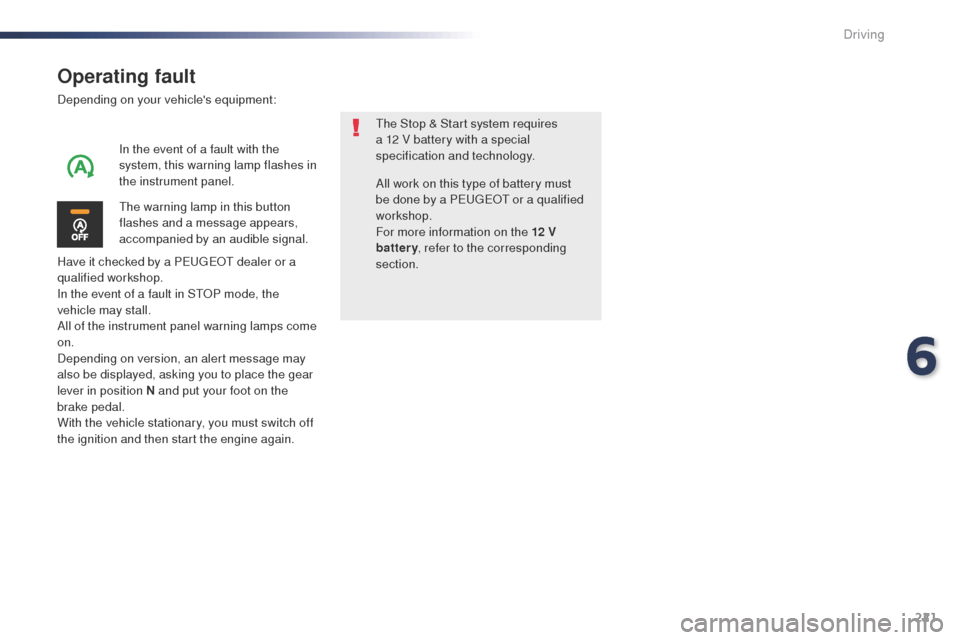
221
Operating fault
Depending on your vehicle's equipment:
Have it checked by a P
e
ugeot dealer or a
qualified workshop.
In the event of a fault in S
t
o
P m
ode, the
vehicle may stall.
All of the instrument panel warning lamps come
on.
Depending on version, an alert message may
also be displayed, asking you to place the gear
lever in position N and put your foot on the
brake pedal.
With the vehicle stationary, you must switch off
the ignition and then start the engine again.
th
e Stop & Start system requires
a 12 V battery with a special
specification and technology.
th
e warning lamp in this button
flashes and a message appears,
accompanied by an audible signal. In the event of a fault with the
system, this warning lamp flashes in
the instrument panel. All work on this type of battery must
be done by a P
e
ugeot or a qualified
workshop.
For more information on the 12 V
battery , refer to the corresponding
section.
6
Driving
Page 244 of 520
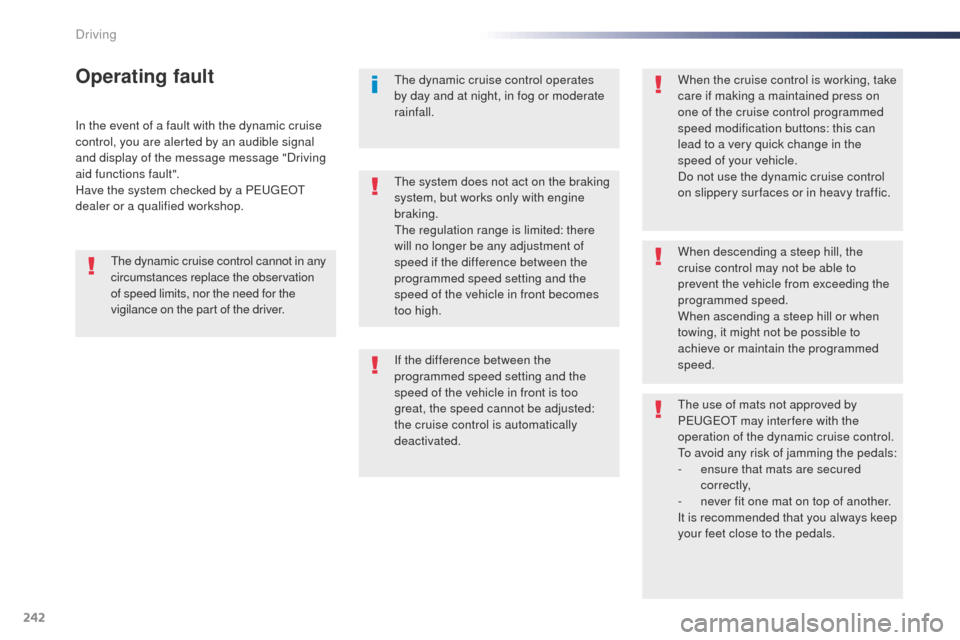
242
In the event of a fault with the dynamic cruise
control, you are alerted by an audible signal
and display of the message message "Driving
aid functions fault".
Have the system checked by a P
e
ugeot
dealer or a qualified workshop.
Operating faultthe dynamic cruise control operates
by day and at night, in fog or moderate
rainfall. When the cruise control is working, take
care if making a maintained press on
one of the cruise control programmed
speed modification buttons: this can
lead to a very quick change in the
speed of your vehicle.
Do not use the dynamic cruise control
on slippery sur faces or in heavy traffic.
When descending a steep hill, the
cruise control may not be able to
prevent the vehicle from exceeding the
programmed speed.
When ascending a steep hill or when
towing, it might not be possible to
achieve or maintain the programmed
speed.
th
e use of mats not approved by
P
e
ugeot may inter fere with the
operation of the dynamic cruise control.
to a
void any risk of jamming the pedals:
-
e
nsure that mats are secured
c o r r e c t l y,
-
n
ever fit one mat on top of another.
It is recommended that you always keep
your feet close to the pedals.
If the difference between the
programmed speed setting and the
speed of the vehicle in front is too
great, the speed cannot be adjusted:
the cruise control is automatically
deactivated.
th
e system does not act on the braking
system, but works only with engine
braking.
th
e regulation range is limited: there
will no longer be any adjustment of
speed if the difference between the
programmed speed setting and the
speed of the vehicle in front becomes
too high.
th
e dynamic cruise control cannot in any
circumstances replace the observation
of speed limits, nor the need for the
vigilance on the part of the driver.
Driving
Page 246 of 520
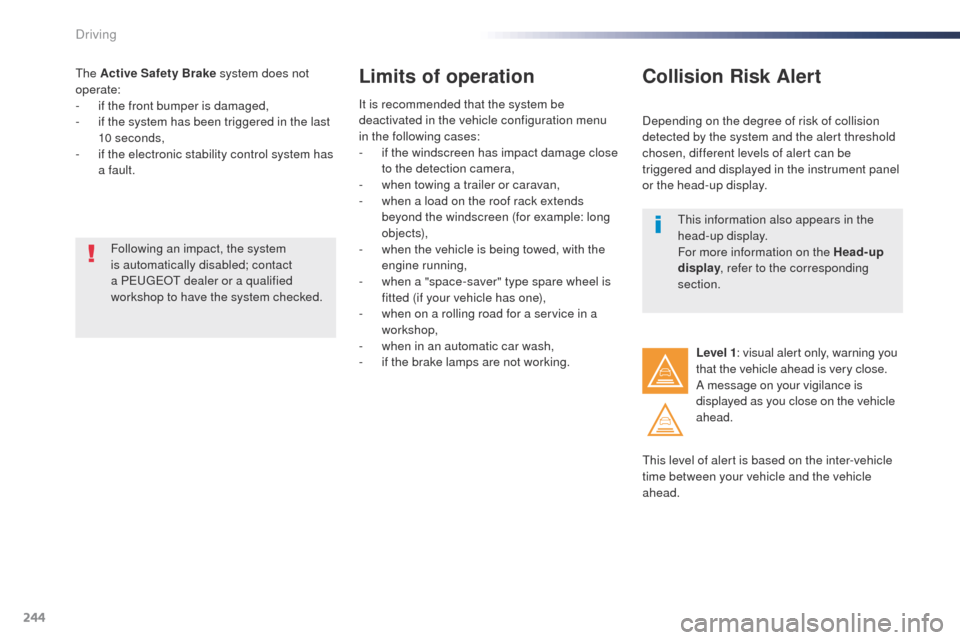
244
the Active Safety Brake system does not
operate:
-
i
f the front bumper is damaged,
-
i
f the system has been triggered in the last
10 seconds,
-
i
f the electronic stability control system has
a fault.Limits of operation
It is recommended that the system be
deactivated in the vehicle configuration menu
in the following cases:
-
i
f the windscreen has impact damage close
to the detection camera,
-
w
hen towing a trailer or caravan,
-
w
hen a load on the roof rack extends
beyond the windscreen (for example: long
objects),
-
w
hen the vehicle is being towed, with the
engine running,
-
w
hen a "space-saver" type spare wheel is
fitted (if your vehicle has one),
-
w
hen on a rolling road for a service in a
workshop,
-
w
hen in an automatic car wash,
-
i
f the brake lamps are not working.
Following an impact, the system
is automatically disabled; contact
a P
e
ugeot
dealer or a qualified
workshop to have the system checked.
Collision Risk Alert
Depending on the degree of risk of collision
detected by the system and the alert threshold
chosen, different levels of alert can be
triggered and displayed in the instrument panel
or the head-up display.
th
is level of alert is based on the inter-vehicle
time between your vehicle and the vehicle
ahead. Level 1
: visual alert only, warning you
that the vehicle ahead is very close.
A message on your vigilance is
displayed as you close on the vehicle
ahead.
th
is information also appears in the
head-up display.
For more information on the Head-up
display , refer to the corresponding
section.
Driving
Page 269 of 520
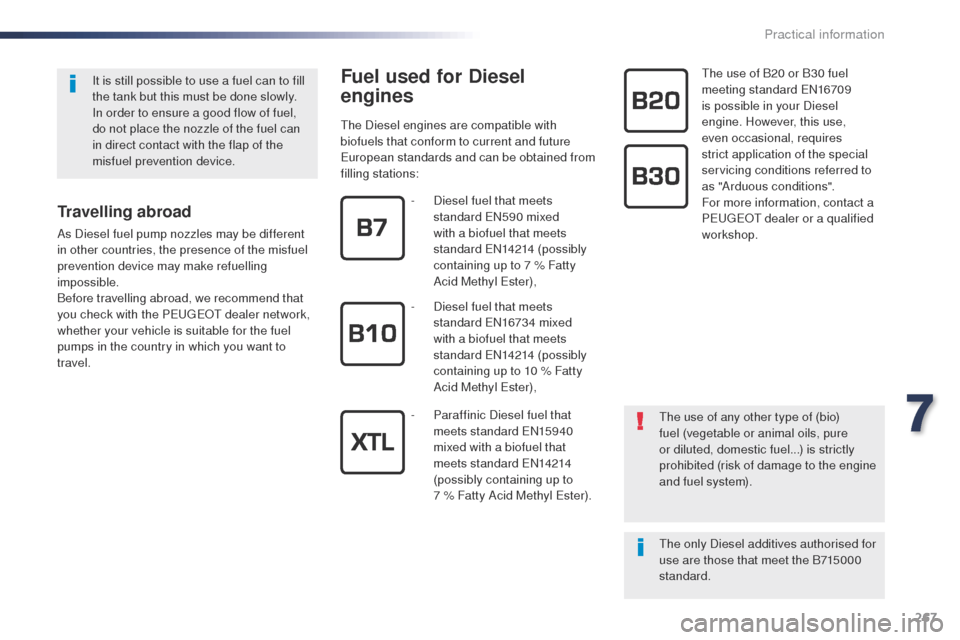
267
Fuel used for Diesel
engines
the Diesel engines are compatible with
biofuels that conform to current and future
eu
ropean standards and can be obtained from
filling stations:
th
e use of B20 or B30 fuel
meeting standard e
N
16709
is possible in your Diesel
engine. However, this use,
even occasional, requires
strict application of the special
servicing conditions referred to
as "Arduous conditions".
For more information, contact a
P
e
ugeot dealer or a qualified
workshop.
It is still possible to use a fuel can to fill
the tank but this must be done slowly.
In order to ensure a good flow of fuel,
do not place the nozzle of the fuel can
in direct contact with the flap of the
misfuel prevention device.
Travelling abroad
As Diesel fuel pump nozzles may be different
in other countries, the presence of the misfuel
prevention device may make refuelling
impossible.
Before travelling abroad, we recommend that
you check with the P
e
ugeot dealer network,
whether your vehicle is suitable for the fuel
pumps in the country in which you want to
travel.
th
e use of any other type of (bio)
fuel (vegetable or animal oils, pure
or diluted, domestic fuel...) is strictly
prohibited (risk of damage to the engine
and fuel system).
th
e only Diesel additives authorised for
use are those that meet the B715000
standard.
-
D
iesel fuel that meets
standard e
N
590 mixed
with a biofuel that meets
standard eN 14214 (possibly
containing up to 7 % Fatty
Acid Methyl
e
s
ter),
-
D
iesel fuel that meets
standard
e
N
16734 mixed
with a biofuel that meets
standard
e
N
14214 (possibly
containing up to 10 % Fatty
Acid Methyl
e
s
ter),
-
P
araffinic Diesel fuel that
meets standard
e
N
15940
mixed with a biofuel that
meets standard
e
N
14214
(possibly containing up to
7
% Fatty Acid Methyl e
s
ter).
7
Practical information
Page 278 of 520
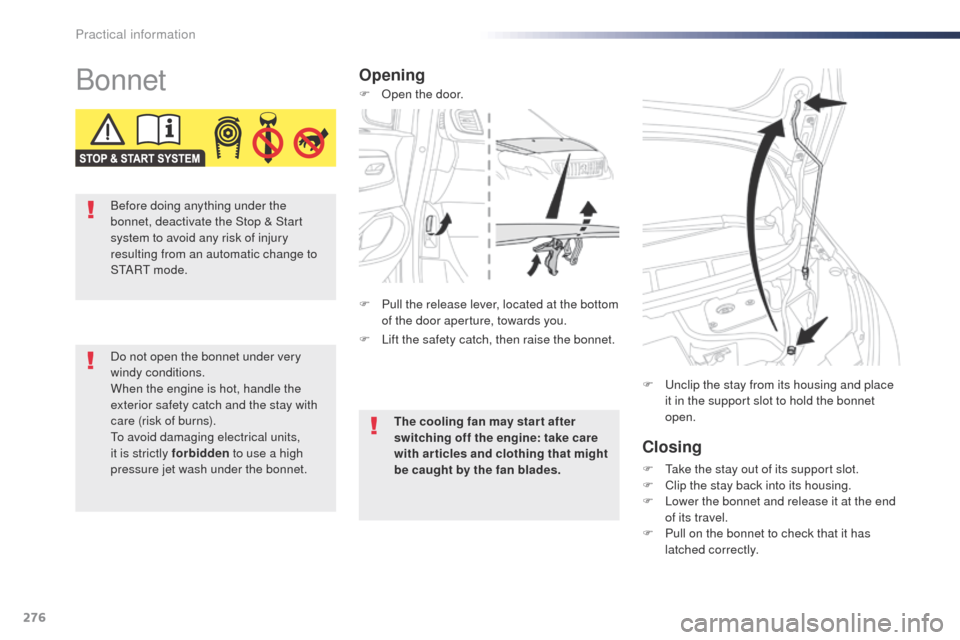
276
BonnetOpeningClosing
F take the stay out of its support slot.
F C lip the stay back into its housing.
F
L
ower the bonnet and release it at the end
of its travel.
F
P
ull on the bonnet to check that it has
latched correctly.
F
u
n
clip the stay from its housing and place
it in the support slot to hold the bonnet
open.
Do not open the bonnet under very
windy conditions.
When the engine is hot, handle the
exterior safety catch and the stay with
care (risk of burns).
to
avoid damaging electrical units,
it is strictly forbidden to use a high
pressure jet wash under the bonnet. The cooling fan may star t after
switching off the engine: take care
with articles and clothing that might
be caught by the fan blades.
F
L
ift the safety catch, then raise the bonnet.
F
o
p
en the door.
F
P
ull the release lever, located at the bottom
of the door aperture, towards you.
Before doing anything under the
bonnet, deactivate the Stop & Start
system to avoid any risk of injury
resulting from an automatic change to
S
t
A R
t m
o d e .
Practical information
Page 280 of 520

278
Checking levels
take care when working under the bonnet, as certain areas of the engine may be extremely hot (risk of burns) and the cooling fan could start at
any time (even with the ignition off).
Engine oil level
the check is carried out either when
the ignition is switched on using the
oil level indicator in the instrument
panel for vehicles so equipped, or
using the dipstick.Checking using the dipstick
the location of the dipstick is shown in the
corresponding underbonnet layout view.
F t
a
ke the dipstick by its coloured grip and
remove it completely.
F
W
ipe the end of the dipstick using a clean
non-fluffy cloth.
F
R
efit the dipstick and push fully down, then
pull it out again to make the visual check:
the correct level is between the marks A
and B .
Check all of these levels regularly, in line with the manufacturer's service schedule.
t
o
p them up if necessary, unless other wise indicated.
If a level drops significantly, have the corresponding system checked by a P
e
ugeot dealer or a qualified workshop.
A = MA X
to e
nsure that the reading is correct, your
vehicle must be parked on a level sur face
with the engine having been off for more than
30
minutes.
It is normal to top-up the oil level between
two services (or oil changes). P
e
ugeot
recommends that you check the level, and top-
up if necessary, every 3 000 miles (5 000 kms). B = MIN
If you find that the level is above the A mark or
below the B mark, do not star t the engine .
-
I
f the level is above the MAX mark (risk
of damage to the engine), contact a
P
e
ugeot dealer or a qualified workshop.
-
I
f the level is below the MIN mark, you
must top-up the engine oil.
Practical information
Page 281 of 520
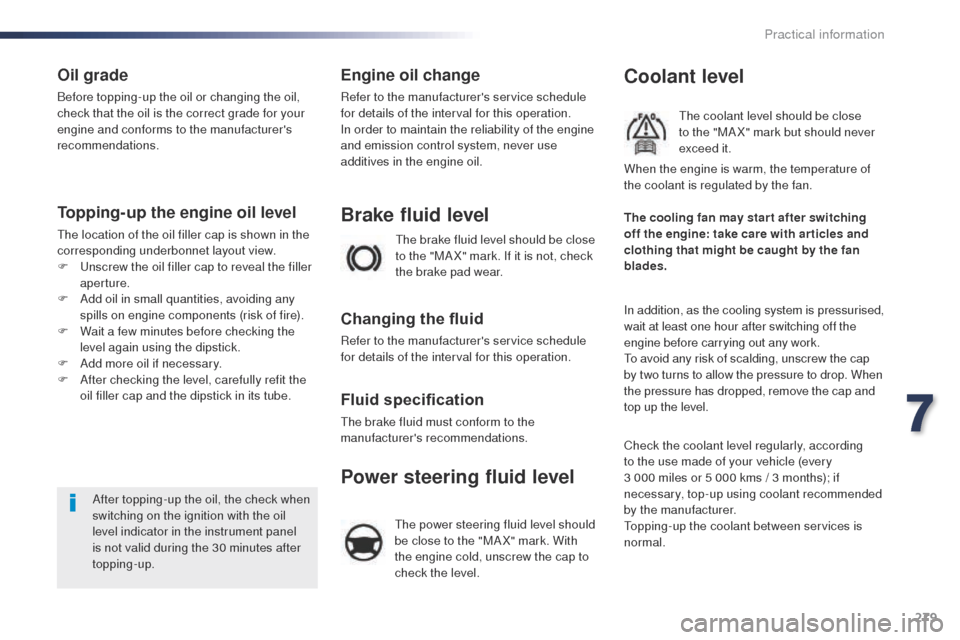
279
Oil grade
Before topping-up the oil or changing the oil,
check that the oil is the correct grade for your
engine and conforms to the manufacturer's
recommendations.
Topping-up the engine oil level
the location of the oil filler cap is shown in the
corresponding underbonnet layout view.
F u
n
screw the oil filler cap to reveal the filler
aperture.
F
A
dd oil in small quantities, avoiding any
spills on engine components (risk of fire).
F
W
ait a few minutes before checking the
level again using the dipstick.
F
A
dd more oil if necessary.
F
A
fter checking the level, carefully refit the
oil filler cap and the dipstick in its tube.
After topping-up the oil, the check when
switching on the ignition with the oil
level indicator in the instrument panel
is not valid during the 30 minutes after
topping-up.
Engine oil change
Refer to the manufacturer's service schedule
for details of the interval for this operation.
In order to maintain the reliability of the engine
and emission control system, never use
additives in the engine oil.
th
e brake fluid level should be close
to the "MA X" mark. If it is not, check
the brake pad wear.
Brake fluid level
Changing the fluid
Refer to the manufacturer's service schedule
for details of the interval for this operation.
Fluid specification
the brake fluid must conform to the
manufacturer's recommendations.
Coolant level
the coolant level should be close
to the "MA X" mark but should never
exceed it.
In addition, as the cooling system is pressurised,
wait at least one hour after switching off the
engine before carrying out any work.
to a
void any risk of scalding, unscrew the cap
by two turns to allow the pressure to drop. When
the pressure has dropped, remove the cap and
top up the level. The cooling fan may star t after switching
off the engine: take care with ar ticles and
clothing that might be caught by the fan
blades. When the engine is warm, the temperature of
the coolant is regulated by the fan.
Check the coolant level regularly, according
to the use made of your vehicle (every
3 000
miles or 5 000 kms / 3 months); if
necessary, top-up using coolant recommended
by the manufacturer.
to
pping-up the coolant between services is
normal.
Power steering fluid level
the power steering fluid level should
be close to the "MA X" mark. With
the engine cold, unscrew the cap to
check the level.
7
Practical information